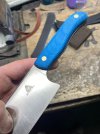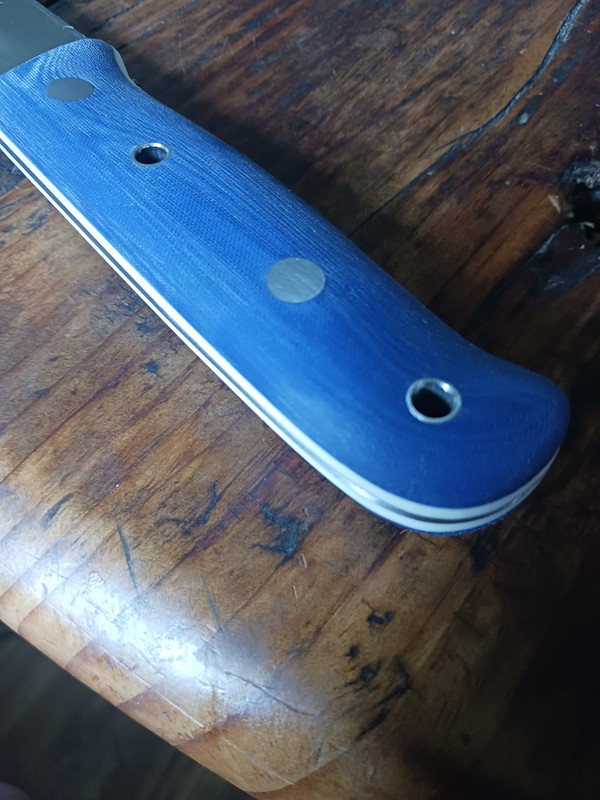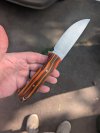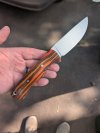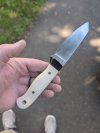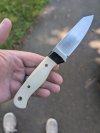-
The BladeForums.com 2024 Traditional Knife is available! Price is $250 ea (shipped within CONUS).
Order here: https://www.bladeforums.com/help/2024-traditional/
You are using an out of date browser. It may not display this or other websites correctly.
You should upgrade or use an alternative browser.
You should upgrade or use an alternative browser.
Nightmarecarta
- Thread starter David Mary
- Start date
Nate Webb
Gold Member
- Joined
- May 30, 2023
- Messages
- 81
I have never run into this problem before. That is until last week. I have some "antique bone" paper micarta I got from Pop's last year which I finally got around to utilizing. That stuff is *horrible*. Gums up belts damn near instantly and burns almost as fast. After I finished that knife I shelved the whole sheet. It looks very nice, but Jesus is it a bear to work with 
Stacy E. Apelt - Bladesmith
ilmarinen - MODERATOR
Moderator
Knifemaker / Craftsman / Service Provider
- Joined
- Aug 20, 2004
- Messages
- 38,262
IMHO, all paper micarta is very hard to work. The ivory/bone ones are the worst. You have to use fresh belts and slow speeds. Above 220 grit you need to switch to hand sanding. It can be lovely, but takes some real work.
- Joined
- Mar 26, 2018
- Messages
- 5,453
You know the stuff. Burns easily, loads belts almost instantly, and a fresh belt is no longer fresh after two passes.
What are your tips and tricks for shaping handle with this stuff? I already use rubber belt erasers but I’ve got a few types of micarta that, once it loads, it’s not going anywhere.
I typically shape with 36 grit AO followed by 150 and then hand sanding.
How can I make life easier?
Thanks!
Those properties you speak of are exactly the reason I have all my modern composites made with phenolic resin, rather than epoxy. You sure get some absolutely beautiful colors from epoxy though... And Greg and Mikie are the best in the business!
Jordan Danz has a very nice how to on instagram when it comes to finishing G-Carta in particular.

G-Carta Finish = @jd_custom_knives
See Instagram 'G-Carta Finish' highlights from Jordan Danz (@jd_custom_knives)
 www.instagram.com
www.instagram.com
- Joined
- Jul 23, 2015
- Messages
- 18,237
Your burl Micartas are very nice to work with Brian.
- Joined
- Oct 18, 2018
- Messages
- 8,499
Your burl Micartas are very nice to work with Brian.
I agree the burl micarta's that are out there are nice and hard, easy to use.....idk who makes them? I think they are in USA?
- Joined
- Mar 26, 2018
- Messages
- 5,453
I agree the burl micarta's that are out there are nice and hard, easy to use.....idk who makes them? I think they are in USA?
The burl phenolics are made by Current Composites in Connecticut. There are a couple of different versions of it.
The red/natural/black canvas (columbia valley), green/natural/black canvas (gifford pinchot), yellow/natural/black canvas (goldfinch), orange/natural/black canvas (wildfire), blue/natural/black canvas (bellingham bay) are pre-preg phenolic recipes that can be carried by any distributor (Maker Material Supply carries them under different names). Because they are a pre-preg recipe, they aren't quite as saturated with resin as the others so I typically recommend either leaving them at a fairly low grit, or taking them to a high polish with sand paper, rather than use a buffer.
All of the other recipes are custom material that are exclusives, and use a wider variety of fabrics (linen, canvas, burlap) and colors. Those recipes (Veda, Shadowlands, Carnelian, Black Cherry, etc) aren't pre-preg material and are much denser. They tend to buff/polish much more nicely. I can't have them made in really bright colors, but there are somewhere around 1,500 combinations available to me.
Last edited:
- Joined
- Oct 18, 2018
- Messages
- 8,499
The burl phenolics are made by Current Composites in Connecticut. There are a couple of different versions of it.
The red/natural/black canvas (columbia valley), green/natural/black canvas (gifford pinchot), yellow/natural/black canvas (goldfinch), orange/natural/black canvas (wildfire), blue/natural/black canvas (bellingham bay) are pre-preg phenolic recipes that can be carried by any distributor (Maker Material Supply carries them under different names). Because they are a pre-preg recipe, they aren't quite as saturated with resin as the others so I typically recommend either leaving them at a fairly low grit, or taking them to a high polish with sand paper, rather than use a buffer.
All of the other recipes are custom material that are exclusives, and use a wider variety of fabrics (linen, canvas, burlap) and colors. Those recipes (Veda, Shadowlands, Carnelian, Black Cherry, etc) aren't pre-preg material and are much denser. They tend to buff/polish much more nicely. I can't have them made in really bright colors, but there are somewhere around 1,500 combinations available to me.
I'll be on the lookout for more, then, from You.
I really liked the stuff.
I'd like a camo version. Brown, green, black, orange. I think that would look neat
Tan works better than brown. Tan, Green, Orange and a bit of black. When the fabrics get wetted out with epoxy, they can darken a lot! Medium blue goes to Navy blue. If you start with most browns, it will be black when it's wetted out.
Camo and Peas and Carrots I did years ago:
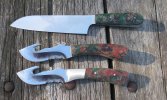
Carbon fiber:
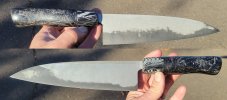
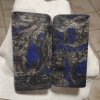
Burlap with glow in the dark pigment in the mix and pins:
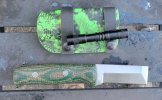
Pink, purple camo:
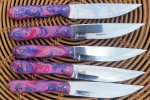
Orange, black and purple:
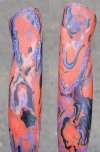
Blue Camos:
Green went really dark on this one, I was hoping it would stay more teal. Cobalt sometimes turns purple when wetter out.

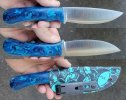
Camo and Peas and Carrots I did years ago:

Carbon fiber:


Burlap with glow in the dark pigment in the mix and pins:

Pink, purple camo:

Orange, black and purple:

Blue Camos:
Green went really dark on this one, I was hoping it would stay more teal. Cobalt sometimes turns purple when wetter out.


- Joined
- Jul 23, 2015
- Messages
- 18,237
- Joined
- Jul 23, 2015
- Messages
- 18,237
Seedy Lot: "Sure I have lots of blue ahem G10"
- Joined
- Oct 18, 2018
- Messages
- 8,499
Maybe it won't be good for edc pocket knife types? Something to slide around in your pocket
ScarFoot
Knifemaker / Craftsman / Service Provider
- Joined
- Sep 16, 2021
- Messages
- 854
I was grinding some of this same stuff yesterday. I’ve worked with it before but I think I learned a few things this go round. If the abrasive loads up it’s going to burn whether you have mist/water or not. The canvas in it is either a brownish/gray color or picks up dirt easily because without any burning it has darker undertones when finished. I had the best luck I’ve ever had with it running a new 36 grit AO belt dry at high speed with a light touch. The belt had no trouble clearing itself like this. Mist or water only seems to cause it to gum up for me. After that I used a felt back 320 grit belt running very slow to knock most of the facets and fuzz off. That helped but didn’t do a great job with the fuzz. Then I actually went over the scales with a 6” half round cut 2 file that I use to cut the pins down. That got rid of the light/fuzzy areas and It was ready for 320 grit hand sanding after that. I had it to 1000 grit within about 30 minutes of filing.View attachment 2909931
View attachment 2909932
Thank you for all your replies. Especially the gentleman who mentioned coolant. I tried dipping the handle in a bucket of water before every pass. My grinder only goes at full speed but this new strategy worked really well and I don’t burn it anymore.
The key is finding whatever combination of belt, speed and pressure that allows the belt to clear itself. I think pressure is more of a factor in burning material than most people realize. I use as light of a touch as possible anytime I’m grinding handles and to do that I generally have to run at a fairly high speed with coarser grits. I don’t press on the belts so much as brush against them.
- Joined
- Oct 19, 2005
- Messages
- 19,912
You know the stuff. Burns easily, loads belts almost instantly, and a fresh belt is no longer fresh after two passes.
What are your tips and tricks for shaping handle with this stuff? I already use rubber belt erasers but I’ve got a few types of micarta that, once it loads, it’s not going anywhere.
I typically shape with 36 grit AO followed by 150 and then hand sanding.
How can I make life easier?
Thanks!
View attachment 2873506
Anytime belt loading is an issue, ie these garage shop micartas and Ironwood for example, give the running belt a spritz w WD40 before starting. Nomore loading.
Wyo Coyote
Gold Member
- Joined
- Nov 25, 2015
- Messages
- 138
I also just heard that side-walk chalk also works, but I haven't tried it yet.

